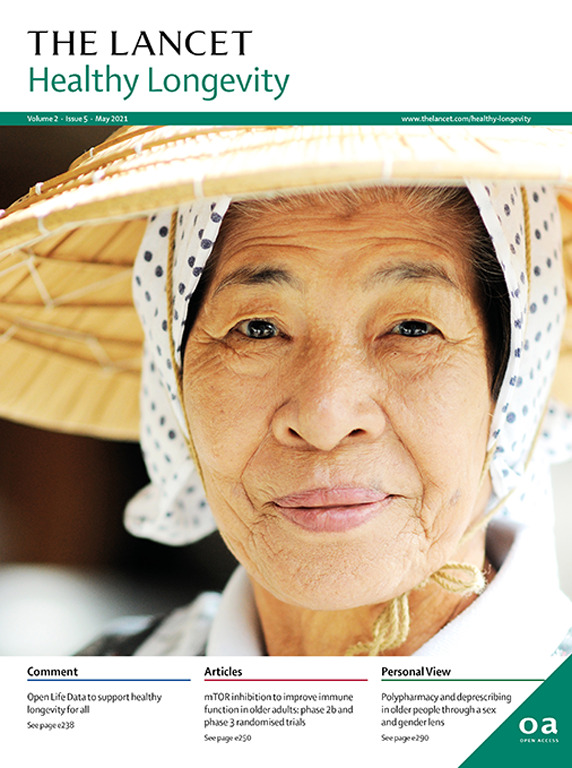Age-specific population attributable fractions for frailty, functional disability, and hospitalisation in Chinese older people: an ICOPE-based prospective cohort study
IF 14.6
Q1 GERIATRICS & GERONTOLOGY
引用次数: 0
Abstract
Background
Declines in intrinsic capacity have been associated with increased risks of frailty, disability, and hospitalisation. We estimated population attributable fractions (PAFs) for these outcomes with respect to intrinsic capacity-related conditions and traditional modifiable risk factors in different age groups.
Methods
We analysed data from a territory-wide, multicentre, community-based, prospective cohort study (2023–24) in Hong Kong. Among 22 237 Chinese adults aged 60 years and older with follow-up data, we calculated age-specific PAFs for incident frailty, instrumental activities of daily living (IADL) disability, and hospitalisation associated with 13 modifiable risk factors. These risk factors included intrinsic capacity conditions, cardiometabolic conditions, and socioeconomic and lifestyle factors, and combinations of these.
Findings
Between March 21, 2023, and Dec 31, 2024, 47 776 participants were recruited to the study. 41 226 (86·3%) had complete baseline data for all intrinsic capacity conditions, cardiometabolic conditions, socioeconomic and lifestyle factors, demographic covariates, and outcome variables and were therefore included in our study sample. 22 237 (53·9%) of 41 226 participants completed follow-up assessments at least 6 months after baseline with a mean follow-up of 360·4 days (SD 71·6, median 348·0, IQR 307·0–399·0), 1398 (7·1%) of 19 777 participants had incident frailty, 1152 (6·0%) of 19 171 participants had incident IADL disability, and 2068 (11·1%) of 18 622 participants were hospitalised. Limited mobility was the leading risk factor associated across all outcomes (PAFs 9·8–25·3%). Depressive symptoms were a strong risk factor associated with frailty (PAF 19·1%). Age-stratified analyses revealed that limited mobility had the highest PAFs in adults aged 80 years and older, whereas depressive symptoms showed peak PAFs in those aged 60–69 years in most cases. Hypertension contributed to all outcomes (PAFs 8·4–19·6%) only in adults younger than 80 years. In adults aged 60–69 years physical activity was the predominant risk factor associated with frailty (PAF 21·9%) and disability (PAF 22·3%). The attributable risk of lower education with frailty increased with age, reaching its peak in adults aged 80 years and older (PAF 20·2%). Regarding the joint effects of the risk factors, intrinsic capacity decline was the factor associated with the highest overall attributable risk for all outcomes, exceeding the impact of cardiometabolic diseases and socioeconomic and lifestyle risk.
Interpretation
Our findings provide insights into age-specific risk factors for frailty, disability, and hospitalisation in older people, underlining the importance of targeted prevention strategies across age groups. Our findings further support a shift towards prioritising intrinsic capacity to better support healthy ageing at the population level.
Funding
The Hong Kong Jockey Club Charities Trust.
中国老年人虚弱、功能残疾和住院的年龄特异性人群归因分数:一项基于icop的前瞻性队列研究
背景:内在能力的下降与虚弱、残疾和住院的风险增加有关。我们估计了不同年龄组中与内在能力相关的条件和传统可改变的危险因素有关的这些结果的人口归因分数(PAFs)。方法:我们分析了来自香港一项区域性、多中心、社区、前瞻性队列研究(2023-24)的数据。在22237名有随访数据的60岁及以上的中国成年人中,我们计算了与13个可改变的危险因素相关的事件性虚弱、日常生活工具活动(IADL)残疾和住院治疗的年龄特异性paf。这些风险因素包括内在能力状况、心脏代谢状况、社会经济和生活方式因素,以及这些因素的组合。研究结果:在2023年3月21日至2024年12月31日期间,47776名参与者被招募到这项研究中。41 226例(86.3%)患者具有所有内在能力状况、心脏代谢状况、社会经济和生活方式因素、人口统计学协变量和结局变量的完整基线数据,因此被纳入我们的研究样本。41 226名参与者中有22 237名(53.9%)在基线后至少6个月完成了随访评估,平均随访3604天(标准差76.1,中位数348.0,IQR 307·0-399·0),19 777名参与者中有1398名(7.1%)发生偶发性虚弱,19 171名参与者中有1152名(6.0%)发生偶发性IADL残疾,18 622名参与者中有2068名(11.1%)住院。活动受限是与所有结果相关的主要危险因素(paf为9.8 - 25.3%)。抑郁症状是与虚弱相关的强烈危险因素(PAF 19.1%)。年龄分层分析显示,80岁及以上的成年人行动受限的paf最高,而大多数情况下,抑郁症状的paf峰值出现在60-69岁的人群。高血压仅在80岁以下的成年人中导致所有结果(paf为8.4 - 19.6%)。在60-69岁的成年人中,体力活动是与虚弱(PAF 21.9%)和残疾(PAF 22.3%)相关的主要危险因素。低学历与虚弱的归因风险随着年龄的增长而增加,在80岁及以上的成年人中达到顶峰(PAF为20.2%)。关于风险因素的共同影响,内在能力下降是与所有结果的最高总归因风险相关的因素,超过了心脏代谢疾病以及社会经济和生活方式风险的影响。解释:我们的研究结果提供了对老年人虚弱、残疾和住院的年龄特异性风险因素的见解,强调了跨年龄组有针对性预防策略的重要性。我们的研究结果进一步支持向优先考虑内在能力的转变,以更好地支持人口层面的健康老龄化。资助:香港赛马会慈善信托基金。
本文章由计算机程序翻译,如有差异,请以英文原文为准。
求助全文
约1分钟内获得全文
求助全文
来源期刊

Lancet Healthy Longevity
GERIATRICS & GERONTOLOGY-
CiteScore
16.30
自引率
2.30%
发文量
192
审稿时长
12 weeks
期刊介绍:
The Lancet Healthy Longevity, a gold open-access journal, focuses on clinically-relevant longevity and healthy aging research. It covers early-stage clinical research on aging mechanisms, epidemiological studies, and societal research on changing populations. The journal includes clinical trials across disciplines, particularly in gerontology and age-specific clinical guidelines. In line with the Lancet family tradition, it advocates for the rights of all to healthy lives, emphasizing original research likely to impact clinical practice or thinking. Clinical and policy reviews also contribute to shaping the discourse in this rapidly growing discipline.
 求助内容:
求助内容: 应助结果提醒方式:
应助结果提醒方式:


